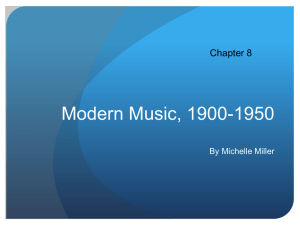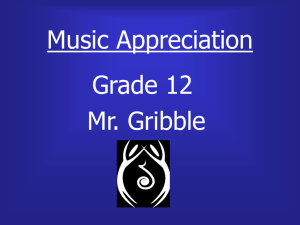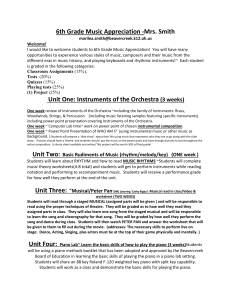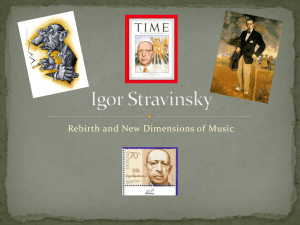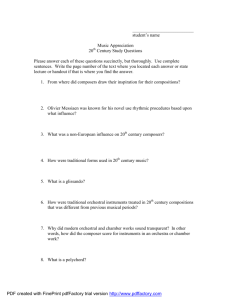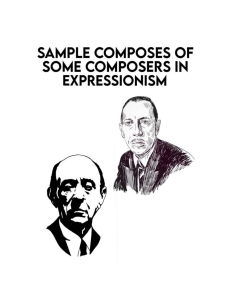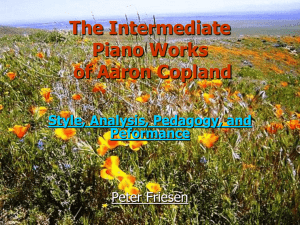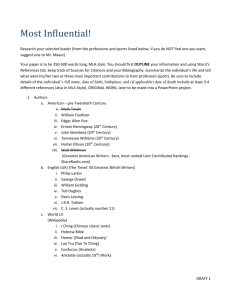Final Exam Study Guide
advertisement
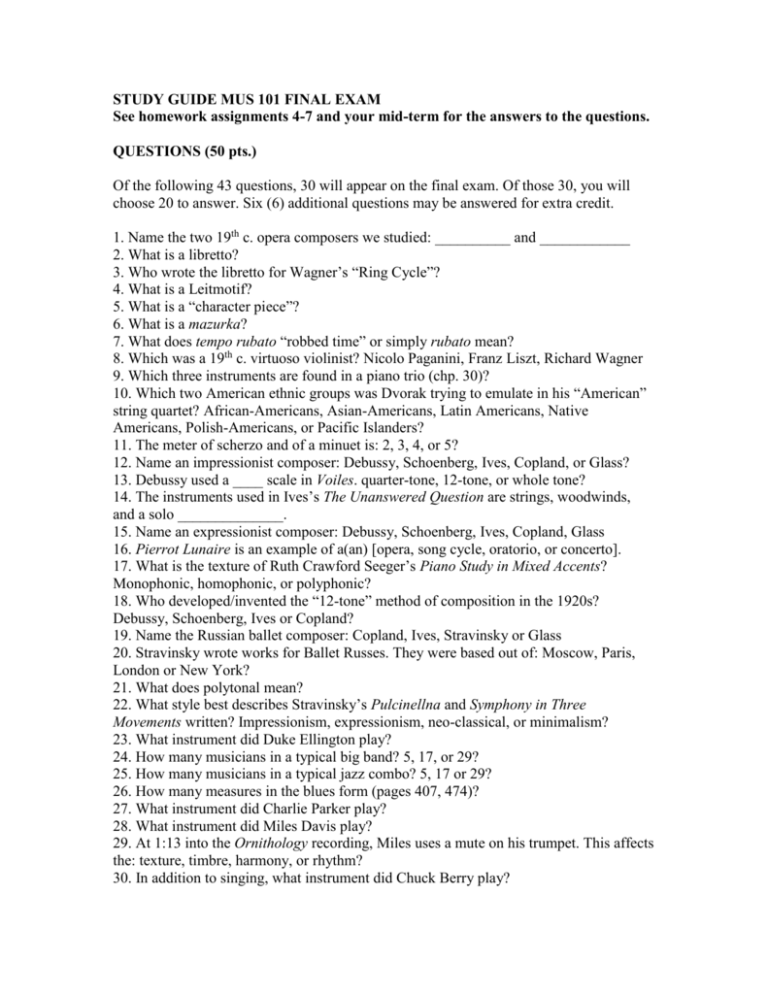
STUDY GUIDE MUS 101 FINAL EXAM See homework assignments 4-7 and your mid-term for the answers to the questions. QUESTIONS (50 pts.) Of the following 43 questions, 30 will appear on the final exam. Of those 30, you will choose 20 to answer. Six (6) additional questions may be answered for extra credit. 1. Name the two 19th c. opera composers we studied: __________ and ____________ 2. What is a libretto? 3. Who wrote the libretto for Wagner’s “Ring Cycle”? 4. What is a Leitmotif? 5. What is a “character piece”? 6. What is a mazurka? 7. What does tempo rubato “robbed time” or simply rubato mean? 8. Which was a 19th c. virtuoso violinist? Nicolo Paganini, Franz Liszt, Richard Wagner 9. Which three instruments are found in a piano trio (chp. 30)? 10. Which two American ethnic groups was Dvorak trying to emulate in his “American” string quartet? African-Americans, Asian-Americans, Latin Americans, Native Americans, Polish-Americans, or Pacific Islanders? 11. The meter of scherzo and of a minuet is: 2, 3, 4, or 5? 12. Name an impressionist composer: Debussy, Schoenberg, Ives, Copland, or Glass? 13. Debussy used a ____ scale in Voiles. quarter-tone, 12-tone, or whole tone? 14. The instruments used in Ives’s The Unanswered Question are strings, woodwinds, and a solo ______________. 15. Name an expressionist composer: Debussy, Schoenberg, Ives, Copland, Glass 16. Pierrot Lunaire is an example of a(an) [opera, song cycle, oratorio, or concerto]. 17. What is the texture of Ruth Crawford Seeger’s Piano Study in Mixed Accents? Monophonic, homophonic, or polyphonic? 18. Who developed/invented the “12-tone” method of composition in the 1920s? Debussy, Schoenberg, Ives or Copland? 19. Name the Russian ballet composer: Copland, Ives, Stravinsky or Glass 20. Stravinsky wrote works for Ballet Russes. They were based out of: Moscow, Paris, London or New York? 21. What does polytonal mean? 22. What style best describes Stravinsky’s Pulcinellna and Symphony in Three Movements written? Impressionism, expressionism, neo-classical, or minimalism? 23. What instrument did Duke Ellington play? 24. How many musicians in a typical big band? 5, 17, or 29? 25. How many musicians in a typical jazz combo? 5, 17 or 29? 26. How many measures in the blues form (pages 407, 474)? 27. What instrument did Charlie Parker play? 28. What instrument did Miles Davis play? 29. At 1:13 into the Ornithology recording, Miles uses a mute on his trumpet. This affects the: texture, timbre, harmony, or rhythm? 30. In addition to singing, what instrument did Chuck Berry play? 31. Which two of these instruments were used in the Beach Boys song that is not commonly found in rock music? drums, guitar, bass, Theremin, cello 32. Which of the following is an aleatoric (chance) composer: Leon, Glass, Adams, Cage 33. In one sentence, describe what happens in Cage’s 4’33: 34. Which one is an American ballet composer? Copland, Ives, Stravinsky or Glass 35. In Rodeo, what instrument does Copland use that is not typically found in the orchestra? Oboe, Theramin, cello, or piano 36. Which of the following is Rondo form? ABA, ABACABA, or ExpositionDevelopment-Recapitulation? 37. Circle the correct four. Bernstein was a: conductor, composer, educator, oboist, pianist, violinist 38. What is the plot of Einstein on the Beach? 39. Philip Glass, Terry Riley, Steve Reich and John Adams are considered: expressionists, neo-classicists, minimalists or post-modernists? 40. Tania Leon, William Bolcom and Luciano Berio are considered: expressionists, neoclassicists, minimalists or post-modernists? 41. In what year did John Adams complete Doctor Atomic? 1965, 1985, or 2005? 42. In what year does Doctor Atomic take place? 1925, 1945 or 1965? 43. One of the singers described one of the songs as sounding like which two Impressionist composers: Debussy and Ravel; Schoenberg and Stravinsky; or Glass and Leon? INSTRUMENTS (12 pts.) 1. Regarding their range, number the string instruments from high (1) to low (4): 2. Name two double reed instruments: 3. Name two woodwinds (non- double reeds): 4. Name two brass instruments: 5. Name four percussion instruments: 6. A string quartet consists of two __________s, a ___________ and a ____________. MUSICAL ELEMENTS (8 pts.) 1. When we hear three or more notes played simultaneously, we often speak of these as a _______________. form, phrase, chord, or frequency? 2. The main note or chord, the one that establishes the key, is called the ____________. sonata, form, gin, or tonic? 3. The measure of intensity and loudness in music is: texture, frequency, dynamics, pitch 4. p (piano) means to play ___________ and f (forte) means to play ____________. 5. The sounds of musical instruments have their own distinctive sound “qualities” or “characters” or “tone colors” also known as: pitch, dynamics, timbre, or rhythm? 6. ___________ is the organization of notes in time in music, including their duration. The “ordering of music through time.” frequency, rhythm, phrase, or dynamics? 7. _____ is the underlying pattern of strong and weak beats. rhythm, phrase, meter, form 8. ______ is a style of singing that “lies somewhere between lyrical song and speech.” a) aria b) recitative c) melismatic d) lieder LISTENING IDENTIFICATION (20 pts.) I will play 10 of the following 14 tracks. Know the title, composer, genre, historical period Verdi Wagner Chopin Fanny Mendelssohn Hensel Dvorak Ives Schoenberg Stravinsky Duke Ellington Charlie Parker Copland Bernstein Philip Glass Tania Leon La Traviata opera The Valkyrie opera Muzurka in B-flat piano character piece Piano Trio, Op. 11 piano trio String Quartet in F string quartet Unanswered Question program music Pierrot Lunaire song cycle Rite of Spring ballet Cotton Tail big band jazz Ornithology bebop jazz Rodeo ballet West Side Story musical Einstein on the Beach opera A la Par percussion ensemble 19th c. 19th c. 19th c. 19th c. 19th c. 20th c. 20th c. 20th c. 20th c. 20th c. 20th c. 20th c. 20th c. 20th c. LISTENING TO MUSICAL ELEMENTS (10 pts.) I will play something that you have not heard. Write a very brief observation for each of the following basic musical elements: 1. Melody: 2. Harmony: 3. Texture: 4. Timbre: 5. Form: 6. Rhythm: 7. Tempo: 8. Dynamics: There will be two questions about the genre of the piece that is played.
